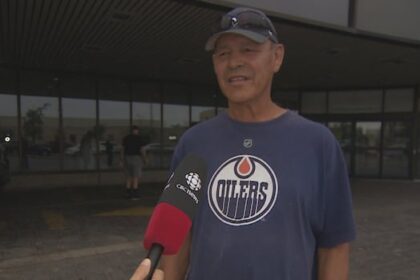EdmontonHunters in northern Alberta are helping scientists test how industrial noise from the oilsands affects moose hunting — a food source and a connection to cultural traditions for many rural and Indigenous communities.Study tests if noise from oilsands operations affects hunters’ ability to call mooseJesmeen Gill · CBC News · Posted: Nov 03, 2025 8:00 AM EST | Last Updated: November 3Listen to this articleEstimated 4 minutesKevin Adby calls for moose using a horn made from birch bark. (Jesmeen Gill/CBC)Hunters in northern Alberta are helping scientists test how industrial noise from the oilsands affects moose hunting — a food source and a connection to cultural traditions for many rural and Indigenous communities.As forest landscapes are cleared for operations, moose habitats become more open, making animals easier to spot, but also exposing them to more predators.For longtime hunter and moose caller Kevin Adby, industrial development has altered his way of hunting in and around Conklin, about 155 kilometres south of Fort McMurray.“You can see moose for miles now, whereas before you didn’t see nothing, you had to go by a track and different strategies,” he said.In a new mandate letter from Premier Danielle Smith to Energy Minister Brian Jean, the province is aiming for higher oil production. But this has some community members raising concerns about how industrial noise is affecting traditional hunting practices.That question led to the Moose Calling Pilot Project, a collaboration between the Conklin Resource Development Advisory Committee, the University of Alberta and the Alberta Biodiversity Monitoring Institute. The study aims to test whether noise from oilsands operations affects hunters’ ability to call and detect moose.“But moose, because they’re so big and have such long legs, they’re able to move through the landscape a lot easier,” explained Peter Fortna, a social scientist involved in the project. “As the landscape becomes more fragmented, it’s harder for them because more predators are able to come and exist on the landscape.”Fortna said community interviews revealed that industrial noise and landscape changes are believed to be impacting how people hunt and how successful they are at calling moose.A statement from the press secretary for the ministry of environment says they are not aware of any significant increases in noise from the oilsands. “As a part of its ongoing research, the Oil Sands Monitoring Program and Indigenous partners will be exploring the effects of sound on moose and other wildlife in the area. We will keep Albertans updated on the results of this work,” the statement said.The experimentThe study is being conducted at two sites — one quiet and one near industrial activity — to measure how sound travels in different environments.Researchers placed five autonomous recording units in a straight line, spaced 80 metres apart, with a fifth positioned 200 metres farther to capture long-distance sound. Hunters perform traditional moose calls at points between the recorders, gradually moving away from the noise source.At the noisy site, existing industrial sounds act as the treatment. In the quiet site, researchers use speakers to play recorded noise from oilsands facilities to simulate similar conditions.The data will show how far moose calls can be detected in each setting, and how noise affects both the call’s reach and hunters’ ability to hear a moose’s response.Alberto De Rosa is a postdoctoral fellow in the University of Alberta’s bioacoustics unit. (Jesmeen Gill/CBC)“I’m very happy to be able to work with local communities,” said Alberto De Rosa, a postdoctoral fellow in the University of Alberta’s bioacoustics unit. “Where I’m from, it’s very rare that scientists and communities actually connect. I feel like we have an actual connection, communication, where they are the experts in their part and we are the experts in our part and bringing these two expertises together kind of makes this possible.”The project is funded through Alberta’s Oil Sands Monitoring Program under its community-based monitoring stream. Results are expected in about a month, once data collection and analysis are complete.Community members told Fortna that hunting around Conklin has become increasingly difficult due to more predators and ongoing habitat fragmentation. Meanwhile, new roads have opened up remote areas to more hunters from outside the community, reducing wildlife numbers and disrupting traditional hunting areas.“It means to prove that the industry does more damage than they said they would, more trees, more deforestation,” said Adby. “Before it was just selected people in a trapline, but now it’s anybody and everybody… you’re losing more animals than you’re supposed to.”ABOUT THE AUTHORJesmeen Gill is a reporter for CBC News in Edmonton. She is a recent graduate from Carleton University’s journalism program in Ottawa and has previously interned at The Canadian Press. You can reach her at jesmeen.gill@cbc.ca.
Monday, 22 Dec 2025
Canada – The Illusion
Search
Have an existing account?
Sign In
© 2022 Foxiz News Network. Ruby Design Company. All Rights Reserved.
You May also Like
- More News:
- history
- Standing Bear Network
- John Gonzalez
- ᐊᔭᐦᑊ ayahp — It happened
- Creation
- Beneath the Water
- Olympic gold medal
- Jim Thorpe
- type O blood
- the bringer of life
- Raven
- Wás’agi
- NoiseCat
- 'Sugarcane'
- The rivers still sing
- ᑲᓂᐸᐏᐟ ᒪᐢᑿ
- ᐅᑳᐤ okâw — We remember
- ᐊᓂᓈᐯᐃᐧᐣ aninâpêwin — Truth
- This is what it means to be human.
- Nokoma











